By Miriam Raftery
January 8, 2025 (La Mesa) – Dozens of public speakers at yesterday’s Grossmont Healthcare District meeting urged the board to move its 9 a.m. meetings to evenings in order to accommodate people with full-time jobs. The proposal was made by newly elected director Nadia Farjood, a working mother who says her new full-time job at the District Attorney’s office prevents her from attending daytime meetings.
The district represents about 520,000 residents. Around 271 people signed a petition in support of Farjood’s proposal, and around 40 showed up in support at yesterday’s meeting. But despite testimony from union representatives, healthcare workers, district residents and local elected officials, Farjood’s proposal failed, with no other director in support.
Some speakers voiced concern not only for Farjood, but for the potential chilling effect on would-be candidates who may be persuaded from running for office if they have full-time day jobs.
Jesse Garcia from the carpenters’ union called it “unfair” and “unAmerican” to “disenfranchise the 23,000 voters” who backed Farjood in the recent election by refusing to accommodate her request, potentially forcing her off of the board. He noted that he serves on multiple boards and committees, which all have evening meetings.
Regina Beasley, a Sharp Healthcare worker and Service Employees International Union (SEIU) member, said restricting meetings to mornings is “discriminatory” based on age, gender and employment status, noting that “most of us in here have children.”
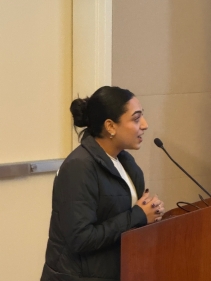 Leila Kater (photo, left) testified that she represents almost 2,000 healthcare workers in the Grossmont district. She told the board that workers “will start paying a lot more attention to these meetings” in order to “hold this board accountable.”
Leila Kater (photo, left) testified that she represents almost 2,000 healthcare workers in the Grossmont district. She told the board that workers “will start paying a lot more attention to these meetings” in order to “hold this board accountable.”
Toni Vargas, a phlebotomist, voiced concerns over "exclusion" of working people including healthcare workers by holding morning meetings, and said avoiding evening meetings is "about preserving power."
Briana Costen, a trustee on the La Mesa Spring Valley School District board, said she was “deeply troubled” by the tone of the discussion. “This is a public board, and you serve the public,” she stated, noting that “75% of voters in this district are below retirement age” and thus likely to have work conflicts that would make it difficult to attend daytime meetings.
Patricia Dillard, Vice Mayor of La Mesa, called for “transparency and accountability.” She said if any member cannot attend evening meetings that are more accessible to the public, “you should have no choice to go get off this board.”
Former La Mesa Councilmember Jack Shu said he would often take calls late at night from constituents. “Public service means you serve the people when it is needed,” he said after dozens of others had spoken out. “I have not heard one person speak in favor of keeping the 9 a.m. time,” he said, noting that the city of La Mesa changed its meetings to 6 p.m. and had an increase in attendance as a result.
Melinda Vasquez said she worked with Farjood and voted for her because “I knew that she would bring a different vantage point to this board...She should not have to quit her day job to do public service.”
Several callers gave remote testimony on Zoom, including La Mesa Councilwoman Lauren Cazares, who praised the “excellent service” she received from the healthcare district after being hit by a drunk driver and injured in December. She noted, “I have a full-time job and am a councilmember. It shouldn’t be difficult to participate in meetings,” then urged the board to “please serve the community that elected all of you.”
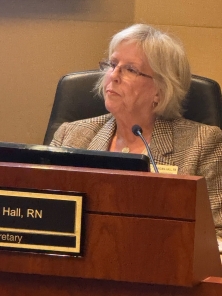 After public testimony, the board held a discussion led by board president Bob Ayres, who thanked everyone for sharing their views.
After public testimony, the board held a discussion led by board president Bob Ayres, who thanked everyone for sharing their views.
Director Virginia Hall disputed claims by some speakers that all board members are retired and should be more flexible. “I do work,” she said, adding that she’s also helped care for her grandson. “It saddens me to hear these comments.” She praised the district for accomplishments including lowering tax rates for taxpayers, giving out $1.5 million in grants to community organizations, receiving a Golden Watchdog Award, and being named the Best Healthcare District in California in 2023.
Hall noted that people who can’t attend in person may participate via Zoom, and noted that the board did launch a pilot program holding meetings at 5 p.m. for six months last year, but that attendance did not increase. She suggested that attendance at meetings is low because the community trusts board members to make wise decisions.
Director Randy Lenac, participating remotely, noted that the head of LAFCO has said the Grossmont Healthcare District is the “gold standard of healthcare districts” and that Sharp Grossmont is a “great hospital.” He voiced support for keeping meetings at 9 a.m. and said the meeting time has been “settled for a long time,” drawing groans from the crowd.
Farjood pointed out that the issue at hand was not whether or not the district has done good work. She then pressed her colleagues over their responses to a survey sent to board members about their availability for meetings at other times. Though all other members had written down a preference to keep meetings at 9 a.m., she noted, “None of the members identified any conflict with 6 p.m..” She said she has seen board members at other evening meetings, including a recent holiday party.
Lenac insisted that “9 a.m. is the best time to assure principal participants can attend,” and insisted that his availability for other times is “irrelevant,” drawing laughter from the audience. He noted, however, that when meetings used to be at 7:30 a.m. he sometimes had to drive through snow from his rural residence, but added, “I never missed a meeting.”
Farjood asked who Lenac considered principal participants, prompting the attorney to try and stop her questioning. This drew shouts from the audience, such as ”No one elected him!” and “Stop speaking down to us!”
Assured she could continue, Farjood stated, “My view is that the public are principals.”
Lenac then clarified that he was referring to members of the hospital who regularly address the board on matters such as healthcare quality, finances, facilities, and future projects.
Farjood said the board is the oversight body for the hospital. “To say we would put the interests of the hospital above the public you’ve heard from today is backwards,” she added. She asked Lenac how he knew that hospital principals couldn’t attend a 6 p.m. meeting, and he admitted, “Well, I don’t know, but I know that 9 a.m. works.”
As for the 5 p.m. pilot program, Farjood called it a “sham” and noted that many people get off work at 5 p.m. and are commuting home at that hour. She also objected to what she views as inadequate outreach by the district, noting that most constituents she met walking precincts said they “never heard of it.”
Farjood clarified that she is not asking the board to change its days, which alternate between Tuesday and Thursday, but only to shift times to 6 p.m. or later.
Hall objected, saying that people are tired at the end of the day, and that traffic can be bad at 6 p.m.
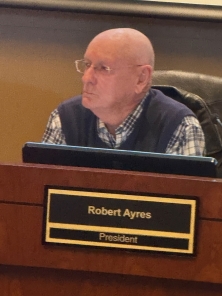 Farjood suggested that better outreach could boost meeting attendance. When Hall asked why so many people showed up at
Farjood suggested that better outreach could boost meeting attendance. When Hall asked why so many people showed up at 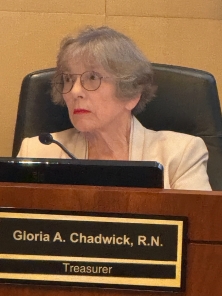 this meeting, when meetings are usually sparsely attended, Farjood replied, “Because I let them know about this,” drawing cheers from the audience.
this meeting, when meetings are usually sparsely attended, Farjood replied, “Because I let them know about this,” drawing cheers from the audience.
Board Chair Gloria Chadwick (photo), a retired nurse and long-time advocate for seniors, noted that some seniors are vision-challenged, particularly with night driving. Pressed on her own availability for evening sessions, Chadwick said, “I will do whatever our board decides.”
Direcftor Ayres (photo,left) said “it’s possible” he could attend evening meetings, but noted that he has an outside full-time job that often requires evening work, including talking with clients in other countries. “Last night I didn’t finish until almost 9 p.m.,” he noted.
As for Farjood’s conflict with attending daytime meetings, Ayres noted that directors are also expected to attend training sessions, committee members, legislative days, grantees’ events and community events, which are often during daytime hours.
Farjood asked why the board needs two meetings a month. She then made a motion asking the board to change to one meeting per month, on the third Thursday at 6 p.m. No member seconded the motion, which died without a vote.
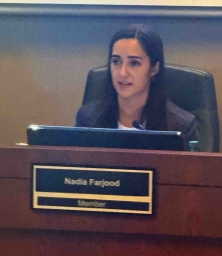 “Today is a dark day for the Grossmont Healthcare District,” concluded Farjood (photo, left), who added that increasing public access was a key part of her campaign. “No amount of years serving on this board can erase the message sent today—that working people cannot serve on this board.”
“Today is a dark day for the Grossmont Healthcare District,” concluded Farjood (photo, left), who added that increasing public access was a key part of her campaign. “No amount of years serving on this board can erase the message sent today—that working people cannot serve on this board.”
But she added defiantly, “I am not going anywhere,” suggesting she may seek accommodation from her employer or, as an attorney, perhaps pursue a legal remedy. “I will be advocating for this at every meeting,” she pledged, thanking all who showed up in support.
East County News Service
January 8, 2025 (La Mesa) -- Forty-seven years after Wait Until Dark premiered on Broadway, Jeffrey Hatcher has adapted Frederick Knott's 1966 original, giving it a new setting. In 1944 Greenwich Village, Susan Hendrix, a blind yet capable woman, is imperiled by a trio of men in her own apartment. As the climax builds, Susan discovers that her blindness just might be the key to her escape, but she and her tormentors must wait until dark to play out this classic thriller's chilling conclusion.
Lamplighters Theatre in La Mesa will present this updated twist on the classic thriller starting January 10 through February 2. Show times are Fridays and Saturdays at 7:30 p.m. and Sundays at 2 p.m., except on Saturday, January 18, there will bea 2 p.m. matinee only.
For tickets, visit https://www.lamplighterslamesa.com/
East County News Service
View raptors and learn about birds of prey at Hawk Watch, hosted by the Wildlife Research Institute at Begent Ranch (18528 Highland Valley Rd.) in Ramona each Saturday in January and February starting at 10 a.m. Arrive early for this free event, with coffee and donuts available starting at 9:30 a.m. It’s recommended to bring binoculars, a folding chair, sturdy shoes and a jacket.
The event begins with an educational biologist’s talk plus a Q&A session with falconry or ambassador raptors that you can see up close and personal. After the 1.5 to 2 hour seated program, you can opt to drive a 2-mile route on paved roads to observe wild raptors including a Bald Eagle nest. Biologists and expert volunteers will help you spot and identify birds and view them through their high-powered professional telescopes.
If it rains, the educational program will be held in the barn, but without the usual falconry flight displays.
Hawk Watch is wheelchair accessible.
For more information, visit https://www.wildlife-research.org/hawkwatch .
By Miriam Raftery
Photo, left: Jamul tribal chairwoman Erica Pinto
January 8, 2025 (Jamul) – On December 23, President Joe Biden signed into law the bipartisan Jamul Indian Village Land Transfer Act, which places 172 acres of land in East County, San Diego into tribal trust for the Jamul Indian Village.
“Thank you to Senators Padilla and Butler, and Representatives Issa and Vargas for their leadership,” Biden said upon signing S. 3857 authored by California Senator Alex Padilla into law. The companion measure in the House was authored by Congressman Darrell Issa.
“The Jamul Indian Village has sought for years to bring tribal members back onto their ancestral land – so they can raise their families, carry forward their culture, and add to their history,” said Rep. Issa when the measure passed the Senate last month. “This is the right thing to do, and it empowers not government, but individuals, to take new charge and best care of their lives. This Fee-to-Trust bill provides that opportunity, securing Jamul’s land, preserving its sacred sites, and protecting Kumeyaay traditions for generations to come. My thanks to Senator Padilla and Congressman Vargas for their support in pushing forth this important legislation.”
The 172 acres are currently owned by the Jamul Indian Village, which includes residential land for homes and council buildings, an ancestral cemetery, and the tribe’s only road for transportation.
“After years of sacrifice in their efforts to achieve self-determination, the Jamul Indian Village will finally get the true homeland they deserve to preserve their sacred history,” said Senator Padilla. “I am honored to have worked alongside the Jamul Indian Village and Congressman Issa to strengthen the Tribe’s community development and permanently safeguard their home for the benefit of their members.”
“For years, the Jamul Indian Village has been fighting to restore their homeland and rebuild their communities. Today, we mark a milestone in these efforts as the Jamul Indian Village Land Transfer Act passes Congress,” said Rep. Juan Vargas. “This bill honors the Jamul Indian Village’s right to place their land into trust, protecting traditions and sacred sites for future generations. Thank you to Congressman Issa and Senator Padilla for their leadership on this issue. It was an honor to work on this legislation alongside my colleagues and Jamul Indian Village leaders, and I look forward to seeing it swiftly signed into law.”
Chairwoman Erica Pinto testified on the legislation, stating, “The Tribe desperately needs additional trust lands so that it may preserve and protect its cultural sites, and develop housing for its members, a health clinic, a grocery store, Tribal administrative offices, law enforcement, educational services, and other community resources in service of the Tribe’s members."
After the bill became law, Chairwoman Pinto told ECM, "This legislation brought out mixed emotions amongst the community but to me, no words can describe what this legislation truly means to my people."
The measures did draw opposition locally. The Jamul-Dulzura Community Planning Group raised concerns over potential commercial development, traffic, and procedures followed, though Chairwoman Pinto has said the tribe would only use the land for purposes specified, including tribal housing, education, administrative offices, and healthcare.
View our prior coverage: https://www.eastcountymagazine.org/bills-propose-adding-172-acres-trust-jamul-indian-village
Read the bill text here.
By Jessica Brodkin Webb
January 7, 2025 (El Cajon) --In 13 days, President-elect Donald Trump could potentially begin to make good on his campaign promise to pursue mass deportations of immigrants and refugees living in the United States.
“As President I will immediately end the migrant invasion of America," Trump said in a Sept, 2024 speech and although he has not released specific details of how he might direct such a plan at a federal level, community leaders stand divided on how best to respond at the local level.
Under current California law, state and municipal governments are barred from working in conjunction with federal law enforcement agencies to actively pursue deportation for anyone who has not committed a serious crime. That approach stands in direct opposition to Trump’s proposed plan to conduct mass immigrant deportations.
El Cajon Mayor Bill Wells, in a letter to the Calif. Attorney General, says he plans to propose that his city fully cooperate with federal immigration authorities. San Diego’s Board of Supervisors majority, by contrast, has urged county authorities not to turn over any immigrants to federal authorities, while the County Sheriff has said she will take the middle ground and follow state law, cooperating only when immigrants have committed serious crimes.
Besides posing a challenge for local elected officials who must decide how they will answer to conflicting state and federal guidelines, an element of murkiness also exists for prominent community members and social service agency heads who spend many hours each week working directly with refugees.
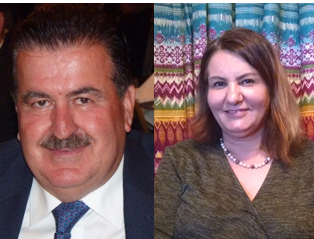 Photos by Miriam Raftery: Noori Barka and Dilkhwaz Ahmed, leaders of El Cajon nonprofits aiding immigrants and refugees, have contrasting views on deportations
Photos by Miriam Raftery: Noori Barka and Dilkhwaz Ahmed, leaders of El Cajon nonprofits aiding immigrants and refugees, have contrasting views on deportations
For example, Chaldean Community Council Founder Noori Barka said he doesn’t like to see people enter the country illegally and supports Trump’s plan to deport immigrants and refugees.
According to the Chaldean Community Council website, the social service organization provides “essential resources and support to help Chaldean and Middle Eastern families build a new life in El Cajon.” For individuals and families who have legally entered the country, they offer assistance with job placement, healthcare coordination, legal guidance and educational assistance among other things.
“I am against any illegal immigration and generally support people coming in the right way. Come like we all came, as immigrants, in a legal way. We have to do the right thing. Come with a degree, a relative, with refugee status.” Barka said.
He believes established members of East County’s Chaldean community, one of the largest in the nation, “came through the legal way” and with vetted backgrounds. Young people with “something to offer” are an asset, he said, including those who are able to enter the country legally with an H1 (work) visa.
However, Barka is concerned that recent waves of immigrants have not been subject to any background investigation and could bring danger to the community.
“People who are coming now, we don’t know their backgrounds and it's scary because sometimes we get criminals. We have to have the right to protect our borders and we have to have the right to allow people who want to come to the county to ask permission, but after we do a background investigation,” Barka said.
Meanwhile, License to Freedom Executive Director Dilkhwaz Ahmed who works daily with domestic violence survivors said some victims arrive undocumented and turning them back around after a harrowing journey to safety puts them at extreme risk. Niche populations such as these, she said, need special and individual consideration outside an all-encompassing policy.
“They’ve traveled thousands of miles to come to a safe country. Sending back those women and children, we put them at risk and what are we going to say: we can’t protect them? This population really needs us to support them, to give them a safe place, get them documents to start as a new human being,” Ahmed said.
Photo, left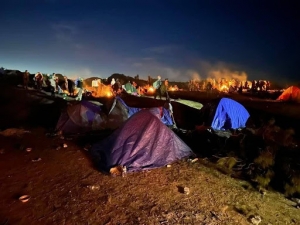 , a migrant encampment near Jacumba in San Diego County has drawn immigrants from around the world.
, a migrant encampment near Jacumba in San Diego County has drawn immigrants from around the world.
The legal process can take years, she explained, from connecting a newly arrived individual to an attorney, then helping them connect their situation with evidence of domestic violence.
“I have a client from Afghanistan, the Taliban killed her husband and it took her seven years to make it to the United States. She called me, scared she would be deported. Imagine what would happen if we send back this woman? What could happen to her? What is her destiny?” Ahmed asked.
The immigrant population she works with “came to the country for democracy, opportunity” and while License to Freedom doesn’t serve many undocumented individuals, there are some, Ahmed said. She wishes some of their cases could be reviewed from a different perspective.
Barka has a no-exceptions outlook on illegal immigration while Ahmed prefers to hear one’s story before deciding how to proceed, yet both rely on individual background information. In contrast, Trump’s plan— albeit lacking in granular details— emphasizes removing as many immigrants as possible regardless of their lived history—even DACA recipients or “Dreamers” brought to this country as children.
Photo, right, 2018 San Francisco rally for young immigrants brought here as children, Protected under DACA, they may now face deportation under the Trump administration
American Civil Liberties Union Executive Director Anthony Romero said, “President-elect Trump will soon have the full power of the U.S. government machinery at his disposal to target and displace immigrants at a scale our nation has never experienced,” prompting the question of where viewpoints like that of Barka, Ahmed or other leaders who parse individual stories from the larger immigrant invasion fit in with public policy.
In the end, Ahmed said, people need to find a sensible solution for immigration policy which she believes can only be attained when people with political differences are willing to sit through a calm conversation and find common ground.
“Deporting criminals? Yes. Why should they be here? But people who come to work and pay taxes, are good human beings and good citizens? We need to stop pointing fingers at each other, start to listen and come up with solutions. Both parties have to give some,” she concluded.
January 8, 2025 (San Diego's East County) -- The National Weather Service has issued a red flag warning for San Diego County mountains and valleys today and tomorrow due to high winds and extreme fire danger. The strong winds that have fueled two large wildfires decimating Los Angeles County are forecast to move into San Diego County next.
This is the driest winter period measured from October 1 through January 8 since 1850, according to the National Weather Service, increasing fire danger.
Due to high winds and potential power outages, schools in six local districts will be closed today. The San Diego County Office of Education announced the closures for:
- Julian Union Elementary School District
- Julian Union High School District
- Mountain Empire Unified School District
- Ramona Unified School District
- Spencer Valley School District
- Warner Unified School District
“The safety of students and school staff is of the utmost importance to San Diego County school districts,” officials said in a news release.
In Los Angeles County, devastating fires have collectively destroyed over 1,000 homes and two people have died, the Los Angeles Times reports.
The Palisades Fire (Photo,left, by Henri Migala) has burned over 2,900 acres and has destroyed many homes, including beachfront houses along Pacific Coast Highway, since it began yesterday morning in Pacific Palisades. Over 30,000 residences have been evacuated in cities including Santa Monita, Topanga, Malibu, and Pacific Palisades.
 Photo, left by Henri Migala: Palisades Fire viewed from Westin Hotel near LAX this morning.
Photo, left by Henri Migala: Palisades Fire viewed from Westin Hotel near LAX this morning.
The Eaton Fire in Altadena/Pasadena soared to 2,227 acres overnight. In Sylmar, the Hurst Fire has burned 500 acres. All of these fires remain zero percent contained.
Governor Gavin Newsom has declared a state emergency due to the Los Angeles County Fires.
The winds fueling these devastating wildfires are moving into San Diego next, posing extreme fire danger here. Some local firefighters are now in L.A. helping to battle those fires.
SDG&E has begun shutting off power to prevent fires in some rural communities, with more outages anticipated.
Please be prepared for power outages and evacuation if necessary.Avoid any actions that could spark a brush fire, such as weed whacking or parking a vehicle atop try brush.
Sign up to receive free East County Wildfire & Emergency Alerts via email at the top right side of our homepage. You can also follow EastCountyAlert on X (formerly Twitter).
By Miriam Raftery
Photo by Henri Migala
January 7, 2025 (Los Angeles) – The fast-moving Palisades Fire has burned 2,921 acres as of tonight, according to Cal Fire. The wildfire that began around 10:30 a.m. in Pacific Palisades has now forced evacuation of approximately 10,000 residents from 30,000 homes in Malibu, Topanga and Pacific Palisades, also forcing closure of portions of Pacific Coast Highway.
The fire is expected to worsen overnight, with extremely dangerous winds up to 100 miles per hour possible, the National Weather Service predicts. Already, gusts up to 70 miles per hour have fueled the conflagration. Wind speeds are expected to peak tomorrow, though strong winds are forecast through Friday.
Both Governor Gavin Newsom and the City of Los Angeles have issued emergency declarations. “This is a highly dangerous windstorm that’s creating extreme fire risk—and we’re not out of the woods,” Newsom said.
The fire has forced closure of multiple schools and burned portions of the Getty Museum property, though museum officials say the museum housing precious works of art is expected to remain safe, thanks to prior brush-clearing on the site.
Some residents racing to flee had to abandon their vehicles amid the fast-moving fire, running to the beach or back home to shelter in place. Firefighters responded to numerous calls, rescuing residents trapped at home, the Los Angeles Times reports.
All residents are urged to evacuate immediately when asked to do so by authorities. Travelers should check on road conditions before visiting the area.
ECM reporter Henri Migala, who is visiting Los Angeles,sent the above photo taken from his hotel room. Another ECM freelancer in Los Angeles on other business advises that the fire has caused long traffic delays for commuters attempting to leave the area.
Cal Fire has activated its Incident Management Team II to assist Los Angeles county and city firefighters.
Evacuation details are available via the Watch Duty App at https://share.watchduty.org/i/40335?ts+1736302139000.
For the latest fire updates from Cal Fire, visit https://fire.ca.gov/incidents/2025/1/7/palisades-fire .
East County News Service
January 6, 2025 (Deerhorn Valley) – Jordan Valladares snapped this close-up portrait of a bobcat near his home on Deerhorn Valley Road south of Jamul on Sunday.
“I spotted the little guy sneaking about while I was enjoying some warm morning sunshine,” he writes. “So I ran in, grabbed my camera and a 300mm lens with a teleconverter, and made my way down into a nearby field. The bobcat was comfortable with my presence, even showcasing some stalking behavior. This allowed me to snap a decent photo at eye level.”
East County News Service
January 6, 2025 (La Mesa) – Tomorrow at 9 a.m., the Grossmont Healthcare District board of directors will consider a proposal by newly elected board member Nadia Farjood to change the board’s meeting times to evenings or weekends. But a survey of board members shows no support for that plan. The board previously experimented with holding evening meetings but found that attendance by the public dropped, multiple members noted.
Farjood, an attorney, has said that her day job prevents her from attending any meetings Monday through Friday between 7:30 a.m. and 6 p.m., when she has court appearances, as well as from 6 to 9 p.m. on the second and third Tuesdays each month.
While the board has changed its meeting times more than once during the past election year, none of its meeting times were during the hours when Farjood has said she could participate.
“Rescheduling the meeting from 9 a.m. time will help accommodate all Board member work schedules and enhance public access,” she states in response to a survey of board members on meeting date/time availability. She also states that she believes weekend meetings are not ideal for staff, leaving only weeknight meetings as options, in her view.
She notes that the La Mesa City Council meetings at 6 p.m., and that both Palomar Health and Fallbrook Regional Health districts’ boards meeting evenings. She also calls on Grossmont to cut meetings from twice monthly to once a month, and for the board to reimburse members for ride-share services or taxis to attend evening meetings.
A petition at Change.org has gathered 217 signatures in support of Farjood’s proposal.though many are from outside the district, The petiion argues that moving meetings to 6 p.m. would enhance accessibility and participation, promote transparency, respect the democratic process, and encourage more people to run for the board.
But the four other board members disagree--and cite past experiences as evidence that daytime meetings have actually increased public participation.
Chair Gloria Chadwick says she supports keeping the current dates and times “because we conducted a pilot program to determine if more participation would be generated at an evening hour. The results were that fewer people attended the evening time slot.” She notes that no public comments or suggestions were received during those evening meetings, “not even from the Zoom meeting public, which included the competing candidates for the three board positions.” She adds, ”Since the 9 a.m. time slot, our attendance numbers have increased.” The meeting time change also reflect input from staff, and it aligns with scheduling of senior health programs offered by the library, where the board meets. Chadwick indicated she would only be available Mondays through Fridays from 7:30 a.m. to 11:30 a.m, except for special or emergency sessions.
Board member Robert Ayres agrees with Chadwick. “After twice revising the current District Board meeting days and time I find that the present schedule is meeting the needs of the District,its staff, the staff of the Hospital, and for Grantee, Scholarships, and Sponsorship awards recognition. The 9 a.m. time is also conductive for presentations made to the District Board for both internal and external presentations.” He notes that Mondays have many holidays that would impact meetings and that Fridays are often not available for people traveling over the weekend. He also voiced concern over nighttime driving safety concerns. He says he supports only Tuesday and Thursday 9 a.m. meetings.
Board member Virginia Hall, who drives from Santee, concurs that, “When we tried the 6-month pilot program at 5 p.m., we did not have any more public attend compared to our previous 7:30 a.m. time. 9 a.m. is a more reasonable time for all,” she states, adding that it is “safer for all to drive during daylight hours and not during rush hour.” Further, she says 9 a.m. meetings allow for more staff involvement and less overtime. In addition, she says Fridays are when “most public, staff and the hospital staff are tired and Friday traffic is generally worse in the afternoon.” She would support meetings only between 9 a.m. and 2 p.m. on weekdays. While she could also be available Saturdays during those hours, she observes,”GHD and hospital staff are usually not available without a financial impact to the taxpayers and hospital” on weekends.
Board member Randy Lenac, in answer to whether he supports keeping the current board meeting dates and times, responded succinctly, “Yes, it works for all concerned.” He did not list any alternative times he could be available.
The board majority’s sentiment is bipartisan; Chadwick is a Democrat, while Ayres, Hall, and Lenac are Republicans. Farjood, a Democrat, has drummed up support for her cause from Run Women Run, though the group has also endorsed Chadwick over the years.
Farjood is correct that changing meeting times to evenings has been done by some other boards to enable working people to attend; examples include Helix Water District and the La Mesa City Council. But her request does not take into account the ract that the Grossmont Healthcare District Board already tried evening meetings, with the opposite outcome. Morning meetings have also been seen as more convenient for doctors and hospital personnel, a factor that cities and other public boards don't need to to consider. On the other hand, the board has the will of voters to consider, and whether keeping a meeting time convenient for the majority is appropriate if it disenfranchises voters whose representative is unable to participate.
If the board declines Farjood’s request to change the meeting dates and times, her options to continue to serve appear limited. A new state law prohibits elected officials from participating remotely, such as on Zoom, more than five times a year for boards that meet more than once a month (or two meetings a year for those meeting monthly or less frequently). The law, AB 2302 which takes effect January 1, 2025, aims to increase interaction with the public in person.
Per Grossmont District policy, a board member who misses three or more consecutive meetings can be removed, with the vacancy filled either by appointment or special election.
Being forcibly removed could be a blight on a record of a public official aspiring to run in the future for another office. Another option is to resign, which would provide Farjood with the opportunity to save campaign donors’ funds for use in a future campaign for another office, but which could disappoint supporters who backed her campaign for the healthcare district board.
While it’s rare for a newly elected official to step down, it is not unprecedented. Helix Water District trustee-elect Luis Tejeda resigned Dec. 30, 2017 before being sworn in, citing a new job that posed conflicts of interest. County Board of Supervisors Chair Nora Vargas resigned effective today despite winning reelection by a landslide, citing safety and security concerns.
East County News Service
January 6, 2025 (Santee) – Jordan Marks, San Diego County Assessor-Recorder-County Clerk (ARCC), has announced that early appointments are now available for civil wedding ceremonies between 8 a.m. and 5 p.m. on Valentine’s Day, Friday, Feb. 14, 2025. Couples can book their Valentine’s Day appointments for marriage licenses and ceremonies at one of four ARCC offices, including Santee, Chula Vista, San Marcos and the San Diego Downtown ARCC headquarters at the County Administration Center, 1600 Pacific Highway, San Diego. The Downtown location also offers indoor ceremony rooms or a picturesque, outdoor marriage arbor on the waterfront. The ARCC Santee branch office in East County is located at 10144 Mission Gorge Ave.
The ARCC office is responsible for issuing marriage licenses, birth and death certificates, as well as registering business names and recording all legal real estate documents. On average, the ARCC office provides nearly 25,000 marriage licenses and performs more than 11,000 weddings annually.
However, Valentine’s Day is historically one of the busiest and most popular days of the year for same-day marriage licensing and civil ceremonies, according to Marks, a countywide elected official who serves as county commissioner of civil marriages in his role as San Diego County ARCC.
“Valentine’s Day 2025 will be extra special this year because it falls on a Friday, allowing for a weekend of fun for the newlyweds,” said Marks. “Happiness begins here at my County Clerk Office for hundreds of couples looking to tie the knot on this unforgettable day. I highly encourage couples to make their Valentine’s Day 2025 appointment now, using my award-winning online booking system to secure their reservation for love on this highly-sought-after day.”
Cost for a non-confidential marriage license is $129. Cost for an ARCC staff member to perform the ceremony is an additional $107. Ceremonies can be conducted in English or Spanish. To make an appointment, visit www.sdarcc.gov, or call (619) 237-0502.